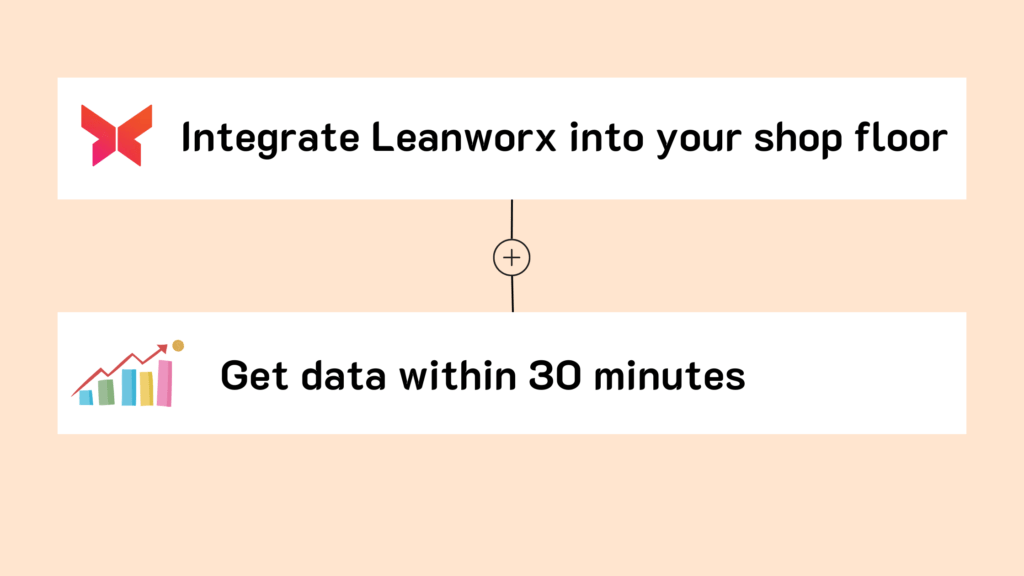
Dasarathi G V
Director in Leanworx
Dasarathi has extensive experience in CNC programming, tooling, and managing shop floors. His expertise extends to the architecture, testing, and support of CAD/CAM, DNC, and Industry 4.0 systems.
Try Leanworx for free
What is Equipment OEE ?
Equipment OEE is a measure of capacity utilization, how efficiently you are using your machines. It therefore has a direct connection to return on investment on plant and machinery, and the company’s profits.
There are multiple ways of calculating the impact of a change in equipment OEE on your profits

How to work out OEE ?
Method 1
If you know your annual profit
If your plant generates an yearly profit of P
Profit per unit of OEE = P / OEE
E.g., if the profit is Rs. 10,000,000 and your equipment OEE if 60 %,
each OEE % translates to Rs. 1,66,666 (10,000,000 / 60)
If the equipment OEE goes up by 10 %, profit increases by Rs. 1,666,660.
Method 2
If you know your revenue, fixed cost and variable costs
Revenue = R
Fixed cost = F
Variable cost = V
Profit = P
Profit = R – F – V
Profit per unit of equipment OEE = P / OEE
E.g., Your plant could theoretically produce 5,000,000 units, and has an OEE of 60 %.
The actual production is 3,000,000 units.
If you sell these for Rs. 40 each, your revenue will be Rs. 120,000,000
Assuming the variable cost per part is Rs. 25 and the fixed cost for the plant is Rs. 12,000,000,
your profit will be 120,000,000 – (25 x 3000000) – 12000000
That is Rs. 33,000,000
Each unit of OEE
Method 3
If you know the proportion of your part’s material cost and processing cost, you can determine the increase in PBT (profit before tax) per unit of OEE.
Equipment OEE improvement will mainly affect the processing cost.
Total part cost = C
Processing cost = S
PBT increase per unit of OEE = S/C
E.g., Processing cost is 30%, material cost is 70%.
If your equipment OEE increases by 20% from from 60% to 80%,
PBT increase = 20 x (30/100) = 6%.
Methods 1 and 2 are from the DuPont analysis technique.
How long does it take to improve equipment OEE ?
We generally think that OEE improvement is a very slow and expensive process, with big changes required in processes, machines and people. On the contrary, it can be extremely rapid and inexpensive, with a machine monitoring system on Industry 4.0. Here are some real stories of equipment OEE improvement in firms that use Leanworx.
Story 1 : Capex freeze, no new machines bought for 2 years
About the Leanworx user
The firm makes machined castings for railway parts and off road vehicles. It has a high variety, low batch sizes. They have CNC lathes, machining centers and foundry equipment, a total of 56 machines. They works two 12-hour shifts, with a 1 hour break in each.
Pre-Leanworx
The machine downtime overall was 46 % of total available time.
Post-Leanworx
Downtime dropped to 22 % in just 5 months, and then dropped further over 2 years. The initial high downtime of 46% prompted the CEO to decide that they would not buy any new machines for 1 year to increase capacity, and would instead increase capacity utilization. The freeze on new machines was then extended by 1 more year. Orders were increasing by 15% annually, which meant that they would have bought 18 new machines in the year that they installed Leanworx. Instead, they postponed buying these machines that would have cost them Rs. 56,000,000. They finally bought a new machine after 2 years.
What caused this equipment OEE improvement ?
In Leanworx, classify downtimes into low hanging fruit and high hanging fruit.
Low hanging fruit are downtimes due to poor work ethics – production starting late at the beginning of the shift, stopping early at the end of the shift, break times extending beyond the allotted, production stoppages during shifts for no reason.
High hanging fruit are due to system problems – machine breakdown, power shutdown, lack of raw material, high setup times, high first-part inspection times.
The low hanging fruit downtimes are culture issues and can be eliminated in a couple of weeks through positive and negative incentives. They require very little time, and no investment. High hanging fruit downtimes take more time to reduce. Some may be fixed by system changes, proper line balancing or better scheduling. Others may require investment in better fixturing, modular tooling, material handling equipment, personnel training, etc.
Leanworx reports on equipment OEE and downtimes showed that low hanging fruit downtimes added up to 1.5 hours per shift, which is 14 % of the scheduled 11 hours per shift. This reduced to almost zero in just 1 month.
The high hanging fruit took longer. Managers analyzed the machine downtimes and their reasons through a variety of Leanworx reports like the big downtime reports, downtime analysis and Pareto charts. They focused on the top downtime reasons continuously to reduce them.
Story 2 : Equipment OEE improvement of 12% in 3 weeks - work ethics improvemen
About the Leanworx user
The firm is an automobile parts manufacturer. They use Leanworx machine monitoring system on 39 CNC machines – turning centers, VMCs, HMCs. They work 3 shifts : 6 AM-2PM, 2PM-10PM, 10PM-6AM. The average machine hour rate is Rs. 500.
Pre-Leanworx
When Leanworx was installed for CNC machine monitoring, in every shift the production started late and ended early. The highest downtimes were at the end of the second shift, and the beginning and end of the third shift. The average downtime was 1 hour per shift, which meant a reduction of 12 % in the production capacity.
Post-Leanworx
After it was announced publicly that CNC machine downtime had started,in just 2 days the downtime dropped by about 25 % on its own, without any action. It further dropped to less than 5 minutes per shift In 3 weeks. Production quantity on all machines increased by 12 % due to this.
What caused this ?
Leanworx has a separate report that shows the machine downtime at the start and end of every shift. The shop head gets this report as an automatic email every morning, for the previous day.
The shop head observed the report for a few days, and then started printing it and putting it up on the shop notice board , for all machines. Everybody got to know everybody else’s downtime at shift change. It became impossible for people to continue with what was basically poor work ethics.
Story 3 : Firm stopped working 3rd shift, in 7 months
About the Leanworx user
The firm makes aerospace parts on 40 machines connected to Leanworx machine monitoring system. The machines are mostly large and expensive VMCs and HMCs, and turning centers. The average machine hour rate Rs. 650.
Pre-Leanworx
The spindle was running 30% of the total time available. Machines were scheduled to run 24 hours, in 3 shifts of 8 hours each.
Post-Leanworx
After 7 months of installing Leanworx, the spindle run time went up from 30% to 64%. The earlier daily production quantity was being done in just 2 shifts instead of 3 shifts. Since orders were static for the year, the firm stopped working in the 3rd shift.
The estimated saving in money terms was Rs. 14,00,000 per month. This was due to reduction in personnel, reduced energy costs, reduced maintenance costs because machines were running fewer hours, etc.
What caused this ?
In aerospace parts manufacture, batch sizes are small and parts variety is large. To measure productivity, we suggest the tracking the spindle utilization % instead of OEE.
Leanworx tracks spindle utilization, the percentage of time that the spindle is working versus the total time that the machine is scheduled to run. Spindle utilization is shown in reports, dashboards, and Andon boards. You can drill down from the utilization to downtime analyses and details, like Pareto charts of durations and reasons.
Leanworx’s machine downtime tracking reports showed that the spindle was running only 30% of the time. Machines were cutting 1/3 of the time, idle 2/3 of the time. The CEO of the firm announced that all personnel would get a salary hike if the spindle utilization went up to 50 %. This had its intended effect, and the spindle utilization went up to 55 % in just 4 months. It further rose to 64 % in 7 months, 70 % in 8 months. The cutting time was now reversed – machines were cutting 2/3 of the time, idle 1/3 of the time.
The earlier high downtime was caused by a combination of systems issues and poor work ethics, like high inspection times, no raw material, high setup times, high downtime at shift change because of late start and early stoppage, etc. The payment incentive motivated the shop teams to work together and reduce all these.
Story 4 : Equipment OEE improvement in just 1 day
About the Leanworx user
The firm is a manufacturer of hydraulic pumps. They have 57 machines connected to Leanworx machine monitoring system. Machines are CNC VMCs and HMCs. They work 3 shifts of 8 hours each.
Pre-Leanworx
For the first 2 days after Leanworx was installed In a bay with 8 HMCs, the Manager noticed a downtime of 1 hour every day on all machines, for the reason ‘Waiting for tool’. The average machine hour rate was Rs. 1000, so this was a monthly loss of Rs. 26,000 per machine.
Post-Leanworx
After Day 3 of installing Leanworx, downtime for ‘Waiting for tool’ reduced to Zero, for all 8 machines. They got a 4 % increase in equipment OEE by eliminating 1 hour downtime every day. And this happened in just 1 day.
What caused this ?
The downtime of 1 hour a day for each machine appeared in downtime tracking reports on the desktops and laptops of supervisors and managers, and in alerts that they received on their mobile phones.
After 2 days of observation, the manager went down to the shop floor to check what was causing this downtime. What he found was that a single allen key set was being shared by the whole bay of 8 machines. Allen keys were used in a number of their tool holders for changing inserts, setting bore gauges, etc. When an operator needed an allen key, he the length of the whole bay to find on which machine it was being used, and then waited till the other operator had finished with it. His machine was down all this time.
The shop manager’s simple solution was to order a set of allen keys for every machine the same afternoon. This involved a one-time investment of Rs. 500 per machine. This small investment resulted in a saving Rs. 26,000 on every machine, every month.
You’re probably thinking, “It’s so obvious ! How could they be so stupid and not give allen keys to every machine ?”. Sure, it looks stupid AFTER we hear the story, but every one of us has such stories in our shop floor.
In this firm, the operators and supervisors just thought that this WAS the system, and they just worked with it. Since nobody thought it was a problem, nobody throughout of informing the manager about it. People in management only came to know of the problem because they started real time downtime tracking. All shop floors have some similar stories.
Story 5 : Operator incentization resulted in 19% equipment OEE increase
About the Leanworx user
The firm is an automobile parts manufacturer with 130 machines connected to Leanworx. The machines are mostly CNC lathes and machining centers, with an average machine hour rate of Rs. 350.
When Leanworx was installed
Operators were being paid fixed salaries, and the salaries had no relation to their performance. Good operators were not rewarded for their motivation level and skill, and bad operators were not being encouraged to improve.
The effect of Leanworx
Equipment OEE improved by 19 % in 3 months, resulting in higher revenue of Rs. 38,000 per machine per month. Operator churn reduced by 42 % in 3 months. Leanworx generates operator productivity data with details of efficiency, rejections, hours worked, etc. There are special reports for HR and payrolls, which are used to pay performance-linked incentives.
Story 6 : Accurate parts production count - in 1 week
About the Leanworx user
The firm mass produces parts on stamping presses, a lot of them high speed . They have 45 machines connected to Leanworx. Part cycles times vary from 3 seconds to 20 seconds, which means 1300 to 9000 parts are produced in each shift.
Pre-Leanworx
Decision makers did not know the accurate production quantities. Quantities were recorded in registers by machine operators, and were rounded off estimates. This resulted in a variety of problems: over-production causing excess inventory and increase in inventory holding cost; under-production causing delivery delays; inability to schedule properly. Equipment OEE calculations were wrong.
Post-Leanworx
Production monitoring system counts the actual number of parts made, at any instant. Reports show hourly and shift-wise production. Over-production and under-production have been eliminated, leading to lower inventory costs, better scheduling, improvement in profitability. Equipment OEE calculations are accurate.
Summary - Equipment OEE and profits
1. There is a direct connection between the OEE and the firm’s profits. When OEE changes, the change in profits can be calculated quickly in a variety of ways.
2. Increase in profits through OEE improvement can be rapid and inexpensive, like the examples above show.
Increase your profits automatically. Use Leanworx to get accurate and instant data 24/7.


